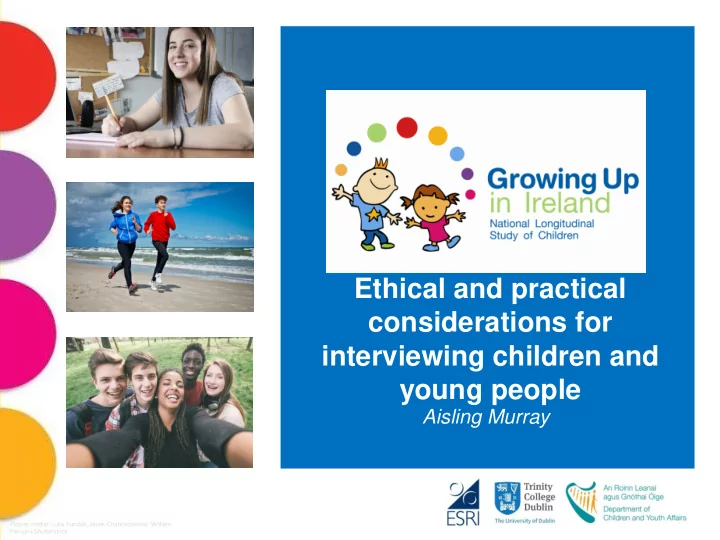

Ethical and practical considerations for interviewing children and young people Aisling Murray Picture credits: Luka Funduk; Jacek Chabraszewski; William Perugini/Shutterstock
Direct child/youth data collection Age Face-to-face Self-complete Cognitive/ Physical interview interview academic measurement assessment 9 yrs Child Cohort 13 yrs 17/18 yrs 9 months Infant Cohort 3 years 5 years 9 years
Outline Procedures • Circa 200 interviewers visit family homes all around the country • Interviewer conducts a face-to-face interview with parents and Study Child/Young Person (where old enough) – Interviewer reads questions from a laptop screen and inputs participants’ answers as they go through the questionnaire – Referred to as ‘CAPI’ format – Computer Assisted Personal Interviewing • Sensitive questions are self-completed by participants – Laptops or paper depending on wave • Interviewer administers cognitive tests – Group completion in school for Wave 1 of Child Cohort – Individual completion in home for other waves • Interviewer takes physical measurements in home
Topics for older children and young people •Cultural and group activities •Work experiences •Driving •Diet and exercise Economic / Civic •Sports and pastimes Participation/ •Sexual education/behaviour Demographics •Smoking/drinking Cognitive/ Health Educational Development •Teachers Socio- •Subjects emotional •Aspirations •Behaviour Development •Ability •Self-concept and personality •Choices for further/higher ed. •Mental health •Relationships with family and friends
Consultation #1 • Consultation with experts – Multi-institute Scientific Advisory Group – Inter-departmental Steering Group – Research Ethics Committee – International advisors commissioned by the DCYA – Stakeholder groups – Other longitudinal studies who have undertaken fieldwork with particular age groups already – Literature reviews • Additional to expertise of the Study Team and Management Group • Feedback from families and interviewers • Legislation
Consultation #2 • Consultation with children and young people – Original development in conjunction with a Children’s Advisory Forum • Network of small groups of children aged 9 years from different schools around the country; organised by GUI • Multiple periods of consultation – More recent focus groups – individual sessions • 9-year-olds for the Infant Cohort – New issues in the past decade (and some old ones) • 17/18 year-olds for Wave 3 of the Child Cohort – Large day session organised by DCYA’s Comhairlí na Óg – Supplemented by sessions in individual schools • Importance – Identify issues of importance – Acceptability/comprehensibility of materials – Include voice of young person from early on in the process
Practicalities #1:Piloting • Piloting of materials and procedures very important, especially with children – ‘ Pre-test’, Pilot, Dress rehearsal (depending on wave) • Test feasibility, acceptability and duration of instrumentation and procedures – Are test materials age-appropriate? – Can they reasonably administered by interviewers in the home setting? – How long do they take? – Are they well-received (or not) by children, young people and parents?
Practicalities #1:Piloting Example: Issues and subsequent clarifications after piloting of cognitive assessments at age 3 years Applicable Issue Guidelines test Prompting/hints by parents or Laminated card reminding parents not Both tests siblings to help to be left in sight during test Child’s English judged by parents Acceptable to administer one but not the other depending on parental to be good enough for the Picture guidance. Screen to indicate this included Similarities but not for the Naming on CAPI separately for both tests Vocabulary Children too shy to talk Administer Picture Similarities (non- verbal) before Naming Vocabulary. For Main Study, gross and fine motor activities precede cognitive tests Child appears to have correct word Give child benefit of the doubt in terms Naming but pronunciation is poor, or child has a of pronunciation, e.g. accept ‘bish’ for Vocabulary speech impediment ‘fish’ Child speaks at too low a volume Child can be asked to repeat the response Source: Table Child gives name of item in Ask child to repeat the response in 6.1, Murray et another language English (once only). Continued other- al. (2014) language response to be marked incorrect
Practicalities #2:Consistency • Household interviews – Use of a structured questionnaire – Use of CAPI method • Correct routing of questions • Feeding forward of earlier information, e.g. names • Range and consistency checks – Interviewer training and assessment – Fieldwork support • Direct Assessments – Training videos – CAPI administration – Role-play
Facilitating informed participation • Advance information sheets • Signed consent forms – Parents may opt out of some parts but still complete the main interview – Own consent (assent) forms and information sheets for children from aged 9 years • Personal visits by interviewers to households – Discuss queries about participation • Questionnaires available in different languages – Special arrangements where necessary • Interviews at evenings, weekends or over multiple visits • Audio assist for child interviews and bespoke arrangements where required
Collecting data from children and young people • Information and consent/assent • Respect for privacy – Self-complete for more sensitive topics – Parents informed that blank, but not completed, questionnaires can be inspected • Facilitating participation – Language, audio assist • Child welfare – Health and safety (e.g. when taking measurements) – Don’t pressurise to take part – Monitor child’s fatigue, embarrassment etc – Specific welfare and protection training
General Child Protection Precautions Preventing direct harm: – Garda vetting of interviewers – Health and character references – ID cards – Interviewers not allowed to be alone with any child – Interviewer training emphasises importance of child welfare – Assessment post-training – Back-checks conducted on every interview – Research Ethics Committee Recognising existing issues: – Intensive training • Signs of child abuse, what to do if the child discloses something to you – Emergency 24/7 telephone number for interviewers to contact study team about immediate concerns – Incident reporting system for all concerns – Appointment of Designated Liaison Officer
Interviewing children requires balance . . . Child Protection Fieldwork Interviewing Research Feasibility Children Quality Participant Relations
Recommend
More recommend